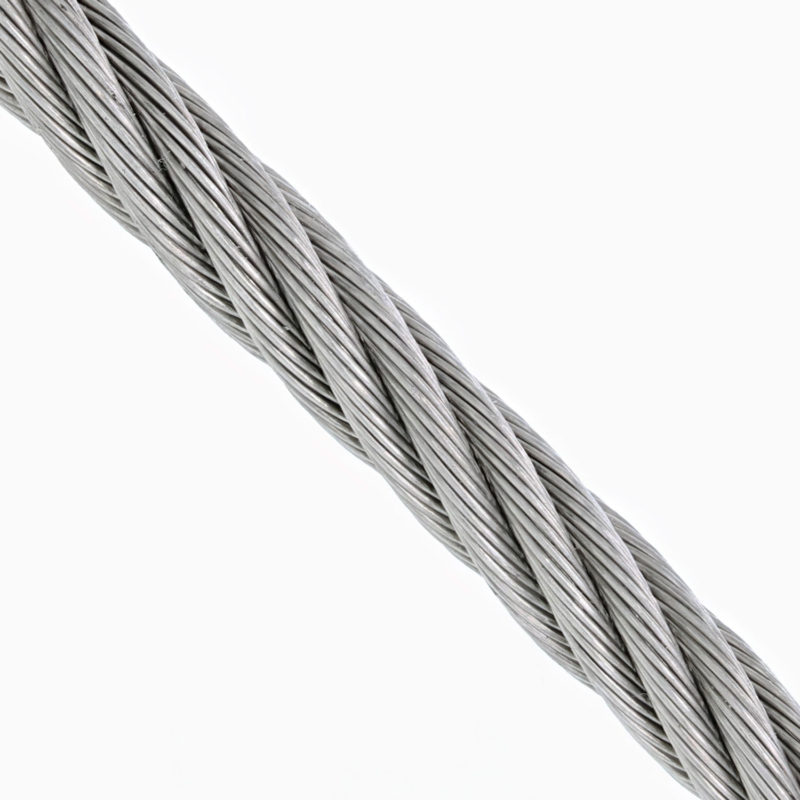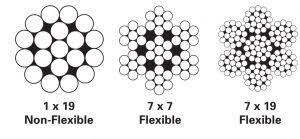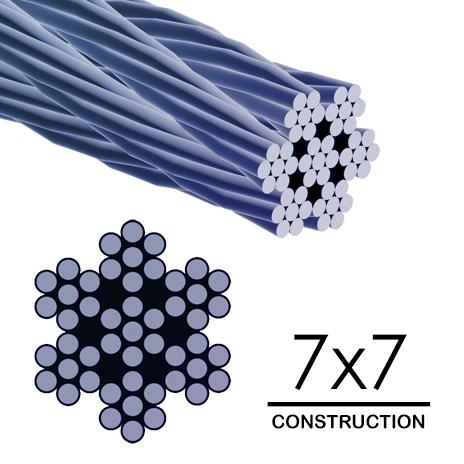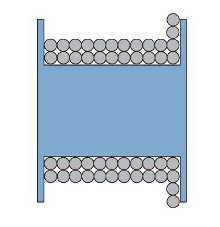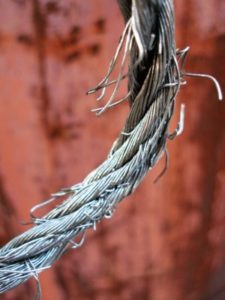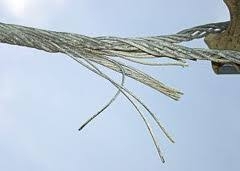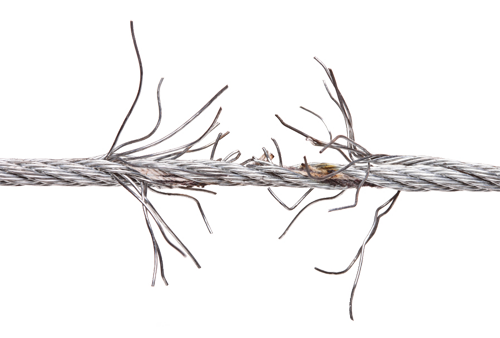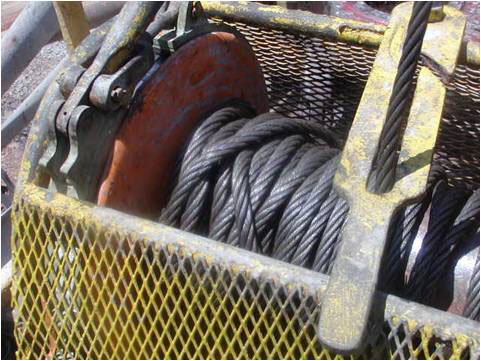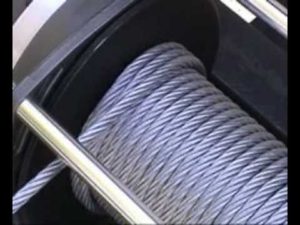NOTHING LASTS FOREVER – EVEN A LIFT CABLE
That’s true! Your cables will eventually need replacement. When? That depends on you. If you’ve been around boat lifts for any length of time you have seen problems with boat lifts. Typical problems include corrosion, chafe, broken strands or kinks on the cables..
Let’s start by looking at the typical construction of a lift cable.
The most common types are the 7 x 7 and 7 x 19 construction. As you can see they are not simply a wire hanging down that lifts your boat up. They are more complex than that.
The individual strands are wrapped together as shown Then they are wrapped again around a core.
HOW DO CABLES GET DAMAGED?
There are two types of wear:
External abrasion
This occurs when the cable bends around the winch drum and lift pulleys. On the winch drum, they rub against the adjoining wire or the drum sides. This rubbing causes wear on the external strands which will eventually wear through the individual stands.
If the cable doesn’t wrap properly, it starts to stack on the side of the winch drum. When the cable eventually slips off the “stack”, even though it is only dropping 1/4″ to 1/2″, the resulting noise shocks anyone nearby. It was under hundreds of pounds of pressure from the boat. This situation is usually caused by misalignment of the winch drum or a poorly threaded situation.
New ShoreMaster winches are attached with a complete housing around the upright post which prevents this from happening due to winch misalignment. More on this later in this discussion.
Internal abrasion
Internal abrasion occurs whenever strands work against each other under load. Each time a boat is raised or lowered over a winch drum, there is internal wear. Each strand of wire in the winding is moving at a slightly different speed. Abrasion of the strands is the result. When you lose too many strands, you lose a lot of strength. This condition cannot be eliminated but it can be controlled by using the proper size winch drum and pulleys.
A point often overlooked – internal abrasion and the resulting corrosion or rust in a galvanized cable, can be hidden and may not show visible damage. A cable like this may sometimes fail without prior warning.
ASSUMING IT IS WELL CARED FOR, HOW LONG SHOULD IT LAST?
Experts say that to be safe, replace a galvanized cable every two years. All things being equal, stainless wires will last longer-up to twice as long. But don’t rush out and try to change all your cables to stainless. Galvanized cable has its place on your lift. For one, they are stronger than stainless steel and can bend easier around the pulley and winch drum.
An improperly positioned boat may send your boat into the water. See https://wisconsinpws.com/boat-lift-safety-updated/ for more information.
When in doubt, replace the cable. Trying to squeeze another year out of the cable isn’t worth the risk of dropping your boat or personal injury.
COMMON PROBLEMS WITH BOAT LIFT CABLES
Chafe or fraying – are those fine broken strands that poke or cut your hands when you slide your hands along the cable. If you catch your clothes when they brush against a cable you have “chafe” or fraying.
Chafe may be the result of faulty sheave alignment or improper drum winding.
Lowering a lift rack without any weight on it, especially on a small lift like a PWC lift, may also result in a “backlash.” This is discussed later.
Note: Be aware that most winches require at least 50 lbs of weight to work correctly.
BROKEN STRANDS
Broken strands are very dangerous. Boat lifts with this type of damage should be replaced immediately.
CORROSION
Corrosion presents a significant problem for galvanized cables. When the protective layer of galvanizing wears through as discussed above, corrosion will begin. Corrosion may not always be visible to the naked eye. The first time you become aware of the corrosion could be when the cable breaks.
Corrosion may also occur “inside” the cable with little or no external evidence of the damage as discussed above. Any cable showing external signs of rust or corrosion needs replacement.
BACKLASH
When a lift is lowered to the bottom and the winch continues to move the result will be a Backlash. If there is insufficient tension on the cables they will “spring” in every direction on the winch drum. When you retighten the cable, the loose cables become snarled and can wrap up like a backlash in a fishing reel.
WHAT IF I EXPERIENCE A BACKLASH?
Whenever a cable experiences a backlash DO NOT use your bare hands to repair the problem (chafe). You won’t soon forget this if it happens to you. People have also lost fingers when a cable snaps back onto a winch drum. Make sure you wear leather gloves and keep tension on the cable at all times. Keep your hand at least 12″ from the winch to prevent entanglement.
When you experience a backlash, lower the boat into the water to prevent the cables from interleaving further on the drum.
Never use bare fingers or pliers to align the cables. As always, carefully handle it to avoid breakage of the wire strands.
Next, unwind the winch while keeping tension on it. Do this until you see the bottom layer on the drum. Re-wrap the cable onto the winch drum while maintaining tension. Rewind it in even layers. Be sure to close any gaps between the cable on the winch drum.
Finally, it is time to return your boat to the lift to raise it, making sure the cable continues to wind smoothly. If the problem persists, call your lift dealer (that’s PWS)
DID YOU REMEMBER THE WIRE “MEMORY”?
“Memory” allows the cable to play out and rewind onto the drum in a neat pattern. The wire must wind in a set pattern. Loose that “memory” and misalignment occurs which will cause the cable to turn against the side of the winch drum.
Maintain tension at all times to prevent the cable from interleafing with the windings in a lower layer. Fill in each layer completely, leaving no gaps.
WHAT’S COMING UP NEXT WEEK?
Next week we give you more information about boat lift cables and what you can do to lengthen their life.
Remember
Pier & Waterfront Solutions (PWS) specializes in all ShoreMaster docks, lifts, and accessories.
We are located in the center of Door County at 7325 St Hwy 57, just south of Sturgeon Bay at the intersection with Idlewild Road. Our staff looks forward to serving all of your waterfront needs.
Call Jerry at 920-493-4404 or Email Jerry@wisconsinpws.com for more information.

